Hygrothermal Simulation of Interior Insulated Brick Wall—Perspectives on Uncertainty and Sensitivity
Abstract
1. Introduction
1.1. Context
1.2. Hygrothermal Modeling
1.3. Objective and Scope
- 1
- When applying modelled hydraulic conductivity what are the consequences of uncertainty regarding the following material properties?
- Capillary absorption coefficient;
- Retention curve.
- 2
- What impact do modeling choices or simplifications have on simulation results? Aspects that herein will be investigated are:
- Reading position of results in simulation model compared to sensor location in physical experiment;
- Isotropic vs. anisotropic wood properties for beam end;
- Including increased permeability along the brick–mortar interface in mortar properties during rain events;
- Presence of a particularly “leaky” mortar joint, due to lower brick–mortar interface quality, and distance of such a joint to the sensor;
- 2D simplification compared to simulation in 3D.
- 3
- What effect is seen from modeling a smart vapor barrier compared to no barrier or traditional barrier?
2. Case Study Description—Materials and Methods
2.1. General
2.2. Masonry Materials
2.3. Interior Structure
2.4. Instrumentation
2.5. Experiment Setup and Climate Sequence
3. Hygrothermal Modeling
3.1. Model Physics
3.2. Limitations
- With material property data mostly available for one direction only, materials are, in general, modeled as isotropic;
- Moisture retention and capillary conductivity as functions of capillary pressure have not been tested for in the current study. Approximate guesstimates have instead been applied, based on the materials’ sorption curves and capillary absorption coefficients, and retention curves of what are believed to be similar materials;
- Interface resistances between materials are not included, i.e., the model assumes full hydraulic contact;
- Hysteresis has not been included. Materials are only modeled on adsorption and absorption data.
3.3. Key Uncertainty Regarding Material Properties
3.4. Simulation Model Design Setup
4. Results and Assessments
4.1. Uncertainty from Hydraulic Conductivity
4.2. Uncertainty from Retention Curve
4.3. Reading Position
4.4. Isotropic vs. Anisotropic Beam End
4.5. Effect of Lumping Mortar Properties and Brick–Mortar Interface Properties
4.6. Effect of “Leaky” Joint Inclusion
4.7. 3D vs. 2D Model
4.8. Effect of SVB
5. Discussion
5.1. Numerical Model Issues
5.2. Capillary Model Evaluation
5.3. Material Properties and Model Uncertainties
- There might be less overall rain uptake in the masonry, due to runoff, in combination with “leaky” joint interfaces enabling leak-like intrusions (infiltrations) through the masonry. This would enable the RH sensor to still show rapid response to rain, while the masonry overall would store less moisture needing to be dried out inwards through the SVB; this, plausibly in combination with interface resistances, lower acting capillary conductivities, or higher vapor diffusivities for the rest of the masonry;
- The exterior finish of the masonry having been brushed with heavily wetted mortar [30] could have closed the surface pores of the bricks, or created a surface coating, that reduces moisture absorption of the bricks;
- The interior insulation structure and mounting of the SVB in the experiment may have been less air-tight than presumed in the simulation model.
5.4. Conservative Modeling Philosophy
6. Conclusions
- Uncertainty in hydraulic conductivity curves for brick and mortar are clearly impacting results, with a large impact on response of RH sensors to rain events, and on the dry-out of beam ends. Large uncertainty regarding the mortar capillary absorption coefficient was likely the dominant cause;
- Altering the retention curves, including subsequent impact on hydraulic-conductivity curves, had moderate to minor impact on the results. However, with the model operating around the highest RH range that the RH readings could detect at the reading location, and with some uncertainty regarding numerical solving, the true impact of altering the retention curves became obscured;
- RH results are sensitive to the results reading position in the model when comparing simulation to experiment, for the experiment sensor located interior to the masonry surface at the masonry–insulation interface. Similar is the case for the beam-end moisture sensor, regarding at what depth into the modeled wood readings are conducted. Consideration should be given to sensor location and behavior in experiments when choosing reading position and when evaluating simulation results;
- Modeling wooden beam end as anisotropic instead of isotropic does influence simulation results;
- Lumping moisture transport along the brick–mortar interface with mortar properties does show more rapid RH response and slightly increased RH at interior masonry surface. It, furthermore, increases moisture content at the beam end compared to results with normal mortar properties. However, the effect is not large enough to ensure the rapid RH response seen of RH sensors to rain events;
- Inclusion of a “leaky” mortar joint, representing considerably faster moisture permeation from rain events along the brick–mortar interface provides results more in line with the rapid RH-sensor response seen in experiment. The inclusion of a “leaky” mortar joint is supported by experiment observations;
- Conservative beam-end moisture content is neither achieved with normal mortar properties nor with lumped properties in 2D simulation. In contrast, a 3D simulation is seen to give much higher moisture content in the beam end and longer dry-out times providing highly conservative results;
- Vapor resistance of SVB has low influence on results during the cold exterior climate. With warm climate, the dry-out towards the interior are highly dependent on SVB vapor resistance. If further product development could achieve lower vapor resistance of a SVB product for high RH environments, this could provide significant benefits with regard to dry-out performance;
- Vapor resistance of SVB has almost insignificant influence on beam-end dry-out under the studied conditions;
- The (conservative) modeling approach clearly overestimated moisture content in the masonry, and within the conservative model framework the distinct dry-out trend seen in two of the three experiment wall segments investigated was not replicated, the model, thus, giving indication of being too conservative in some respects.
Author Contributions
Funding
Data Availability Statement
Acknowledgments
Conflicts of Interest
Appendix A. Hygrothermal Formulas and Material Properties
| Material | wsat [kg/m3] | wcap [kg/m3] | wlim [kg/m3] | Aw [kg/(m2s1/2)] | μdry [-] | λ [W/(m∙K)] | cp [J/(kg∙K)] | ρ [kg/m3] |
|---|---|---|---|---|---|---|---|---|
| Brick high IRA | 310.8 a | 255.74 a | 2.5 e | 0.188 a | 13.36 a | 0.45 c | 1000 c | 1723 a |
| LC mortar | 294 a | 258.79 a | 18 e | 0.025 a | 18.81 a | 0.82 c | 1000 c | 1806 a |
| Gypsum | 720 d | 353 d | 6 e | 0.0397 d | 6 b | 0.25 b | 850 d | 720 b |
| Spruce longitudinal | 600 | 600 d | 60 e | 0.00688 d | 4.213 d | 0.23 d | 1500 | 455 d |
| Spruce radial/tangential | 600 | 600 d | 60 e | 0.000933 d | 8.426 f | 0.09 d | 1500 | 455 d |
| Mineral wool | 992 d | 232 d | 0.61 e | - | 1.3 d | 0.034 b | 850 d | 17 b |
| Asphalt sill gasket | - | - | - | - | - | 0.553 | 1500 | 1200 |
| Material | nw,0 | lw,1 | lw,2 | lw,3 | lw,4 | cw,1 | cw,2 | cw,3 | cw,4 | nw,1 | nw,2 | nw,3 | nw,4 |
|---|---|---|---|---|---|---|---|---|---|---|---|---|---|
| Brick high IRA a | 0.7 | 0.12 | 0.66 | 0.22 | 0 | 8.67 × 10−7 | 6.72 × 10−6 | 4.00 × 10−5 | - | 4 | 4 | 5 | - |
| LC mortar b | 0.4 | 0.07 | 0.55 | 0.36 | 0.02 | 7.41 × 10−8 | 4.20 × 10−7 | 1.13 × 10−6 | 2.00 × 10−5 | 3 | 5 | 4 | 2 |
| Gypsum c | 1.2 | 0.11 | 0.44 | 0.35 | 0.10 | 1.81 × 10−7 | 2.24 × 10−6 | 5.52 × 10−6 | 1.48 × 10−5 | 2.6 | 6 | 4 | 1.8 |
| Spruce c | 0.6 | 0.10 | 0.50 | 0.30 | 0.10 | 7.02 × 10−8 | 1.03 × 10−6 | 3.43 × 10−6 | 6.18 × 10−5 | 2.2 | 5 | 1.8 | 1.6 |
| Mineral wool c | 4 | 0.13 | 0.51 | 0.36 | 0 | 2.06 × 10−6 | 1.48 × 10−5 | 7.40 × 10−5 | - | 5 | 2.8 | 1.8 | - |
| Material | λsat [W/(m∙K)] a | bw1 [W/(m∙K)] | bw2 [W/(m∙K)] |
|---|---|---|---|
| Brick high IRA | 1.35 b | 0.9 | 0 |
| LC mortar | 1.5 b | 0.68 | 0 |
| Gypsum | 1.16 b | 0.91 | 0 |
| Spruce | 0.7097 b | 0.4797 | 0 |
| Mineral wool | 0.5975 c | 0.0159 | 0.5476 |
| Asphalt sill gasket | 0.553 | 0 | 0 |
Appendix B. Modeling of the SVB
| RH\RH | 0 | 11 | 25 | 30 | 33 | 40 | 45 | 50 | 55 | 60 | 65 | 70 | 75 | 80 | 85 | 90 | 95 | 100 |
|---|---|---|---|---|---|---|---|---|---|---|---|---|---|---|---|---|---|---|
| 0 | 107 | 104 | 100 | 96.8 | 93 | 82 | 73 | 63 | 52 | 42 | 32 | 22 | 14 | 8.6 | 4.4 | 1.4 | 0.43 | 0.26 |
| 11 | 104 | 101 | 97.5 | 94 | 90 | 79.6 | 70 | 60 | 50 | 40 | 30 | 20.5 | 12 | 7 | 3.6 | 1.15 | 0.36 | 0.22 |
| 25 | 100 | 97.5 | 92 | 89 | 86 | 76 | 66.5 | 57 | 46 | 37 | 28 | 19 | 10 (3) | 5.4 | 2.6 | 0.82 | 0.29 | 0.174 |
| 30 | 96.8 | 94 | 89 | 86 | 83 | 73 | 63 | 53 | 43 | 34 | 26 | 17 | 9 | 4.9 | 1.9 | 0.7 | 0.265 | 0.158 |
| 33 | 93 | 90 | 86 | 83 | 79 | 68 | 58 | 48 | 38.5 | 30 | 22 | 14.8 | 8 | 3.9 | 1.45 | 0.62 | 0.25 | 0.148 |
| 40 | 82 | 79.6 | 76 | 73 | 68 | 52 | 40 | 30 | 23 | 17 | 11.5 | 7.5 | 4.1 | 2 | 0.92 | 0.46 | 0.22 | 0.127 |
| 45 | 73 | 70 | 66.5 | 63 | 58 | 40 | 28.5 | 21 | 15 | 10.5 | 7 | 4.2 | 2.4 | 1.2 | 0.7 | 0.37 | 0.2 | 0.114 |
| 50 | 63 | 60 | 57 | 53 | 48 | 30 | 21 | 15 | 10 | 6.9 | 4.4 | 2.65 | 1.4 | 0.88 | 0.54 | 0.3 | 0.18 | 0.102 |
| 55 | 52 | 50 | 46 | 43 | 38.5 | 23 | 15 | 10 | 6.8 | 4.8 | 3.1 | 1.7 | 0.96 | 0.65 | 0.42 | 0.25 | 0.16 | 0.091 |
| 60 | 42 | 40 | 37 | 34 | 30 | 17 | 10.5 | 6.9 | 4.8 | 3.2 | 2.1 | 1.21 | 0.74 | 0.51 | 0.32 | 0.21 | 0.14 | 0.08 |
| 65 | 32 | 30 | 28 | 26 | 22 | 11.5 | 7 | 4.4 | 3.1 | 2.1 | 1.42 | 0.9 | 0.58 | 0.4 | 0.26 | 0.18 | 0.12 | 0.07 |
| 70 | 22 | 20.5 | 19 | 17 | 14.8 | 7.5 | 4.2 | 2.65 | 1.7 | 1.21 | 0.9 | 0.65 | 0.45 | 0.31 | 0.22 | 0.155 | 0.105 | 0.06 |
| 75 | 14 | 12 | 10 (3) | 9 | 8 | 4.1 | 2.4 | 1.4 | 0.96 | 0.74 | 0.58 | 0.45 | 0.34 | 0.24 | 0.18 | 0.13 | 0.09 | 0.052 |
| 80 | 8.6 | 7 | 5.4 | 4.9 | 3.9 | 2 | 1.2 | 0.88 | 0.65 | 0.51 | 0.4 | 0.31 | 0.24 | 0.19 | 0.145 | 0.105 | 0.075 | 0.045 |
| 85 | 4.4 | 3.6 | 2.6 | 1.9 | 1.45 | 0.92 | 0.7 | 0.54 | 0.42 | 0.32 | 0.26 | 0.22 | 0.18 | 0.145 | 0.115 | 0.085 | 0.06 | 0.04 |
| 90 | 1.4 | 1.15 | 0.82 | 0.7 | 0.62 | 0.46 | 0.37 | 0.3 | 0.25 | 0.21 | 0.18 | 0.155 | 0.13 | 0.105 | 0.085 | 0.065 | 0.05 | 0.035 |
| 95 | 0.43 | 0.36 | 0.29 | 0.265 | 0.25 | 0.22 | 0.2 | 0.18 | 0.16 | 0.14 | 0.12 | 0.105 | 0.09 | 0.075 | 0.06 | 0.05 | 0.04 | 0.03 |
| 100 | 0.26 | 0.22 | 0.174 | 0.158 | 0.148 | 0.127 | 0.114 | 0.102 | 0.091 | 0.08 | 0.07 | 0.06 | 0.052 | 0.045 | 0.04 | 0.035 | 0.03 | 0.025 |

Appendix C. Model Algorithm Validation

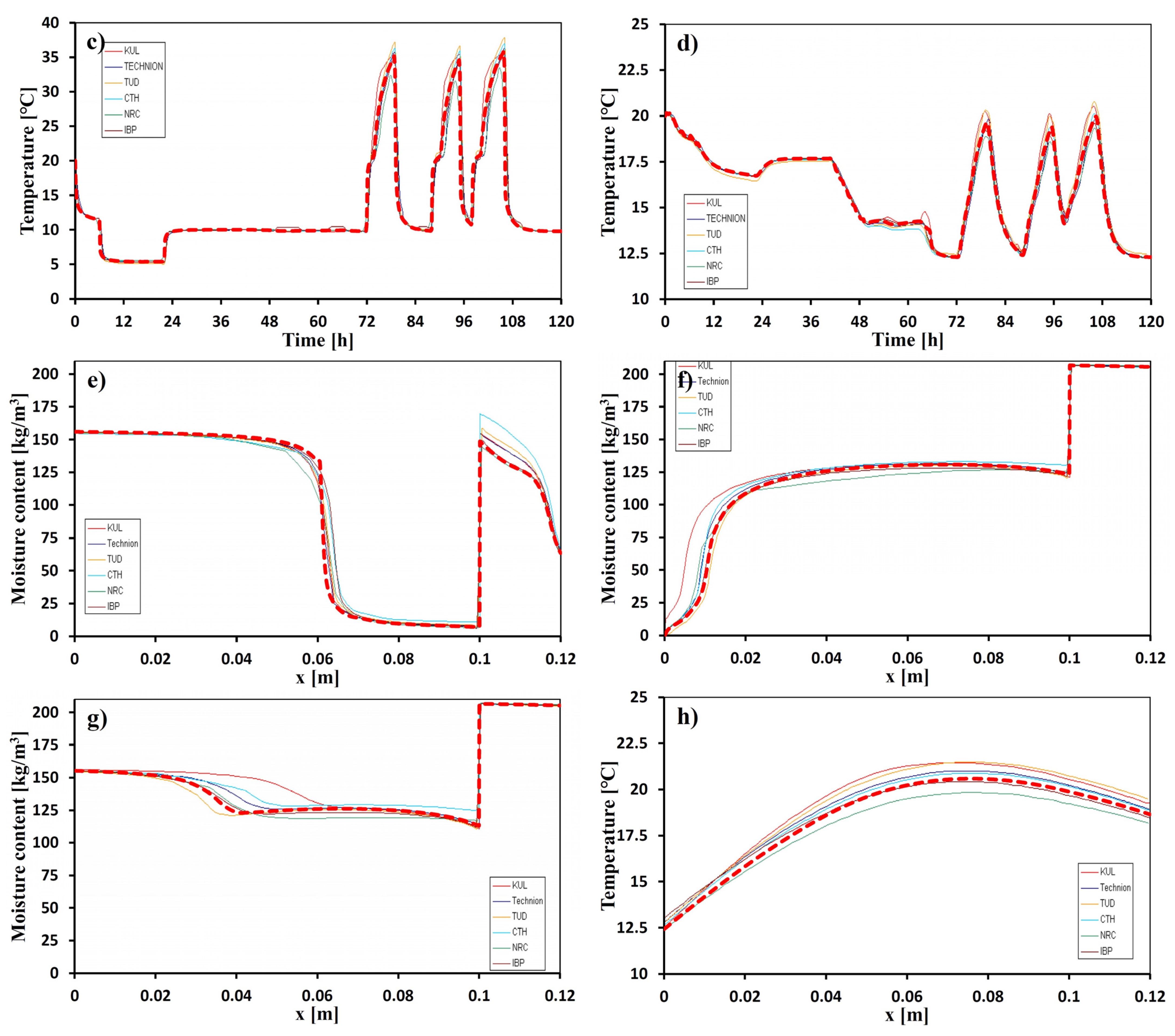
References
- Odgaard, T.; Bjarløv, S.P.; Rode, C. Interior insulation—Characterisation of the historic, solid masonry building segment and analysis of the heat saving potential by 1d, 2d, and 3d simulation. Energy Build. 2018, 162, 1–11. [Google Scholar] [CrossRef]
- Harrestrup, M.; Svendsen, S. Full-scale test of an old heritage multi-storey building undergoing energy retrofitting with focus on internal insulation and moisture. Build. Environ. 2015, 85, 123–133. [Google Scholar] [CrossRef]
- Harrestrup, M.; Svendsen, S. Internal insulation applied in heritage multi-storey buildings with wooden beams embedded in solid masonry brick façades. Build. Environ. 2016, 99, 59–72. [Google Scholar] [CrossRef]
- Zhou, X.; Carmeliet, J.; Derome, D. Influence of envelope properties on interior insulation solutions for masonry walls. Build. Environ. 2018, 135, 246–256. [Google Scholar] [CrossRef]
- Vereecken, E.; Roels, S. Wooden beam ends in combination with interior insulation: An experimental study on the impact of convective moisture transport. Build. Environ. 2019, 148, 524–534. [Google Scholar] [CrossRef]
- Jensen, N.F.; Bjarløv, S.P.; Rode, C.; Møller, E.B. Hygrothermal assessment of four insulation systems for interior retrofitting of solid masonry walls through calibrated numerical simulations. Build. Environ. 2020, 180, 107031. [Google Scholar] [CrossRef]
- Martel, T.; Rirsch, E.; Simmonds, A.; Walker, C. The monitoring of wall moisture in a property retrofitted with Internal Wall Insulation. Case Stud. Constr. Mater. 2021, 14, e00520. [Google Scholar] [CrossRef]
- Zhou, X.; Derome, D.; Carmeliet, J. Analysis of moisture risk in internally insulated masonry walls. Build. Environ. 2022, 212, 108734. [Google Scholar] [CrossRef]
- Johansson, P.; Wahlgren, P. Deterioration in brick buildings: Hygrothermal performance and measures to save them. In Proceedings of the 12th Nordic Symposium on Building Physics (NSB 2020), Tallinn, Estonia, 6–9 September 2020. [Google Scholar]
- Huerto-Cardenas, H.E.; Leonforte, F.; Aste, N.; Del Pero, C.; Evola, G.; Costanzo, V.; Lucchi, E. Validation of dynamic hygrothermal simulation models for historical buildings: State of the art, research challenges and recommendations. Build. Environ. 2020, 180, 107081. [Google Scholar] [CrossRef]
- Martín-Garín, A.; Millán-García, J.A.; Terés-Zubiaga, J.; Oregi, X.; Rodríguez-Vidal, I.; Baïri, A. Improving Energy Performance of Historic Buildings through Hygrothermal Assessment of the Envelope. Buildings 2021, 11, 410. [Google Scholar] [CrossRef]
- Blocken, B.; Derome, D.; Carmeliet, J. Rainwater runoff from building facades: A review. Build. Environ. 2013, 60, 339–361. [Google Scholar] [CrossRef]
- Calle, K.; Coupillie, C.; Janssens, A.; Van Den Bossche, N. Implementation of rainwater infiltration measurements in hygrothermal modelling of non-insulated brick cavity walls. J. Build. Phys. 2019, 43, 477–502. [Google Scholar] [CrossRef]
- Kubilay, A.; Zhou, X.; Derome, D.; Carmeliet, J. Moisture modeling and durability assessment of building envelopes—Recent advantages. In Building Performance Simulation for Design and Operation, 2nd ed.; Jan, L.M.H., Roberto, L., Eds.; Routledge: London, UK, 2019; pp. 270–314. [Google Scholar]
- Ramirez, R.; Ghiassi, B.; Pineda, P.; Lourenço, P.B. Experimental characterization of moisture transport in brick masonry with natural hydraulic lime mortar. Build. Environ. 2021, 205, 108256. [Google Scholar] [CrossRef]
- Scheffler, G. Validation of Hygrothermal Material Modelling under Consideration of the Hysteresis of Moisture Storage; Dresden University of Technology: Dresden, Germany, 2008. [Google Scholar]
- Knarud, J.I.; Kvande, T.; Geving, S. Modelling hydraulic conductivity for porous building materials based on a prediction of capillary conductivity at capillary saturation. Int. J. Heat Mass Transf. 2022, 186, 122457. [Google Scholar] [CrossRef]
- Scheffler, G.A.; Plagge, R. A whole range hygric material model: Modelling liquid and vapour transport properties in porous media. Int. J. Heat Mass Transf. 2010, 53, 286–296. [Google Scholar] [CrossRef]
- Van Belleghem, M.; Steeman, M.; Janssen, H.; Janssens, A.; De Paepe, M. Validation of a coupled heat, vapour and liquid moisture transport model for porous materials implemented in CFD. Build. Environ. 2014, 81, 340–353. [Google Scholar] [CrossRef]
- Derluyn, H.; Janssen, H.; Carmeliet, J. Influence of the nature of interfaces on the capillary transport in layered materials. Constr. Build. Mater. 2011, 25, 3685–3693. [Google Scholar] [CrossRef]
- Vereecken, E.; Roels, S. Hygric performance of a massive masonry wall: How do the mortar joints influence the moisture flux? Constr. Build. Mater. 2013, 41, 697–707. [Google Scholar] [CrossRef]
- Brocken, H.J.P. Moisture Transport in Brick Masonry: The Grey Area between Bricks; Technische Universiteit Eindhoven: Eindhoven, The Netherlands, 1998. [Google Scholar]
- Zhou, X.; Desmarais, G.; Vontobel, P.; Carmeliet, J.; Derome, D. Masonry brick–cement mortar interface resistance to water transport determined with neutron radiography and numerical modeling. J. Build. Phys. 2020, 44, 251–271. [Google Scholar] [CrossRef]
- Kahangi Shahreza, S.; Niklewski, J.; Molnár, M. Novel water penetration criterion for clay brick masonry claddings. Constr. Build. Mater. 2022, 353, 129109. [Google Scholar] [CrossRef]
- Groot, C.J.W.P.; Gunneweg, J.T.M. The influence of materials characteristics and workmanship on rain penetration in historic fired clay brick masonry. Heron 2010, 55, 141–153. [Google Scholar]
- Hens, H.S.L.C. The vapor diffusion resistance and air permeance of masonry and roofing systems. Build. Environ. 2006, 41, 745–755. [Google Scholar] [CrossRef]
- Vereecken, E.; Van De Walle, W.; Roels, S. A novel and flexible test setup to measure the vapour diffusion resistance of building materials and wall components. In Proceedings of the 4th Central European Symposium on Building Physics (CESBP 2019), Prague, Czech Republic, 2–5 September 2019. [Google Scholar]
- Gutland, M.; Bucking, S.; Santana Quintero, M. A methodology for hygrothermal modelling of imperfect masonry interfaces. J. Build. Phys. 2021, 44, 485–509. [Google Scholar] [CrossRef]
- Johansson, P.; Geving, S.; Hagentoft, C.-E.; Jelle, B.P.; Rognvik, E.; Kalagasidis, A.S.; Time, B. Interior insulation retrofit of a historical brick wall using vacuum insulation panels: Hygrothermal numerical simulations and laboratory investigations. Build. Environ. 2014, 79, 31–45. [Google Scholar] [CrossRef]
- Knarud, J.I.; Geving, S.; Kvande, T. Moisture performance of interior insulated brick wall segments subjected to wetting and drying—A laboratory investigation. Build. Environ. 2021, 188, 107488. [Google Scholar] [CrossRef]
- Zhao, J.; Plagge, R. Characterization of hygrothermal properties of sandstones—Impact of anisotropy on their thermal and moisture behaviors. Energy Build. 2015, 107, 479–494. [Google Scholar] [CrossRef]
- Feng, C.; Janssen, H. Hygric properties of porous building materials (VII): Full-range benchmark characterizations of three materials. Build. Environ. 2021, 195, 107727. [Google Scholar] [CrossRef]
- Hansen, T.K.; Bjarløv, S.P.; Peuhkuri, R.H.; Harrestrup, M. Long term in situ measurements of hygrothermal conditions at critical points in four cases of internally insulated historic solid masonry walls. Energy Build. 2018, 172, 235–248. [Google Scholar] [CrossRef]
- Andreotti, M.; Bottino-Leone, D.; Calzolari, M.; Davoli, P.; Dias Pereira, L.; Lucchi, E.; Troi, A. Applied Research of the Hygrothermal Behaviour of an Internally Insulated Historic Wall without Vapour Barrier: In Situ Measurements and Dynamic Simulations. Energies 2020, 13, 3362. [Google Scholar] [CrossRef]
- Defraeye, T.; Blocken, B.; Carmeliet, J. Influence of uncertainty in heat–moisture transport properties on convective drying of porous materials by numerical modelling. Chem. Eng. Res. Des. 2013, 91, 36–42. [Google Scholar] [CrossRef]
- Vereecken, E.; Van Gelder, L.; Janssen, H.; Roels, S. Interior insulation for wall retrofitting—A probabilistic analysis of energy savings and hygrothermal risks. Energy Build. 2015, 89, 231–244. [Google Scholar] [CrossRef]
- De Mets, T.; Tilmans, A.; Loncour, X. Hygrothermal assessment of internal insulation systems of brick walls through numerical simulation and full-scale laboratory testing. Energy Procedia 2017, 132, 753–758. [Google Scholar] [CrossRef]
- COMSOL Inc. COMSOL Multiphysics; COMSOL Inc.: Stockholm, Sweden, 2021. [Google Scholar]
- Knarud, J.I.; Geving, S. Implementation and Benchmarking of a 3D Hygrothermal Model in the COMSOL Multiphysics Software. Energy Procedia 2015, 78, 3440–3445. [Google Scholar] [CrossRef]
- Knarud, J.I.; Geving, S. Comparative study of hygrothermal simulations of a masonry wall. Energy Procedia 2017, 132, 771–776. [Google Scholar] [CrossRef]
- Künzel, H.M. Simultaneous Heat and Moisture Transport in Building Components; Fraunhofer IRB-Verlag: Stuttgart, Germany, 1995. [Google Scholar]
- Tariku, F.; Kumaran, K.; Fazio, P. Transient model for coupled heat, air and moisture transfer through multilayered porous media. Int. J. Heat Mass Transf. 2010, 53, 3035–3044. [Google Scholar] [CrossRef]
- Tariku, F. Whole Building Heat and Moisture Analysis; Concordia University: Montreal, QU, Canada, 2008. [Google Scholar]
- Hagentoft, C.-E.; Kalagasidis, A.S.; Adl-Zarrabi, B.; Roels, S.; Carmeliet, J.; Hens, H.; Grunewald, J.; Funk, M.; Becker, R.; Shamir, D. Assessment method of numerical prediction models for combined heat, air and moisture transfer in building components: Benchmarks for one-dimensional cases. J. Therm. Envel. Build. Sci. 2004, 27, 327–352. [Google Scholar] [CrossRef]
- Tsilingiris, P.T. Thermophysical and transport properties of humid air at temperature range between 0 and 100 °C. Energy Convers. Manag. 2008, 49, 1098–1110. [Google Scholar] [CrossRef]
- Fraunhofer WUFI 2D 4.2; Fraunhofer IBP: Stuttgar, Germany, 2019.
- Ruisinger, U.; Kautsch, P. Comparison of hygrothermal 2D- and 3D-simulation results with measurements from a test house. E3S Web Conf. 2020, 172, 08004. [Google Scholar] [CrossRef]
- Zhou, X.; Carmeliet, J.; Derome, D. Assessment of moisture risk of wooden beam embedded in internally insulated masonry walls with 2D and 3D models. Build. Environ. 2021, 193, 107460. [Google Scholar] [CrossRef]
- Janssen, H.; Blocken, B.; Carmeliet, J. Conservative modelling of the moisture and heat transfer in building components under atmospheric excitation. Int. J. Heat Mass Transf. 2007, 50, 1128–1140. [Google Scholar] [CrossRef]
- Janssen, H. Comment on Cabrera et al. A User-Friendly Tool to Characterize the Moisture Transfer in Porous Building Materials: FLoW1D. Appl. Sci. 2020, 10, 5090, Appl. Sci. 2022, 12, 1123. [Google Scholar]
- Piaia, J.C.Z.; Cheriaf, M.; Rocha, J.C.; Mustelier, N.L. Measurements of water penetration and leakage in masonry wall: Experimental results and numerical simulation. Build. Environ. 2013, 61, 18–26. [Google Scholar] [CrossRef]
- NS-EN 15026; Hygrothermal Performance of Building Components and Building Elements. Assessment of Moisture Transfer by Numerical Simulation. Norwegian Standards: Oslo, Norway, 2007.
- Zhou, X.; Derome, D.; Carmeliet, J. Robust moisture reference year methodology for hygrothermal simulations. Build. Environ. 2016, 110, 23–35. [Google Scholar] [CrossRef]
- Johansson, P.; Lång, L.; Capener, C.-M. How well do mould models predict mould growth in buildings, considering the end-user perspective? J. Build. Eng. 2021, 40, 102301. [Google Scholar] [CrossRef]
- Kalamees, T. Hygrothermal Criteria for Design and Simulation of Buildings; Tallinn University of Technology: Tallinn, Estonia, 2006. [Google Scholar]
- Hens, H.S. Modeling the heat, air, and moisture response of building envelopes: What material properties are needed, how trustful are the predictions? J. ASTM Int. 2007, 4, 1–11. [Google Scholar] [CrossRef]
- Marincioni, V.; Marra, G.; Altamirano-Medina, H. Development of predictive models for the probabilistic moisture risk assessment of internal wall insulation. Build. Environ. 2018, 137, 257–267. [Google Scholar] [CrossRef]
- Janssen, H.; Freudenberg, P.; Tijskens, A.; Hou, T. Basic Probabilistic Analysis of Hygrothermal Performance of Interior Insulation; KU Leuven: Leuven, Belgium, 2019; p. 108. [Google Scholar]
- ISO 13823; General Principles on the Design of Structures for Durability. ISO: Geneva, Switzerland, 2008.
- Lacasse, M.A.; Morelli, M. A Systematic Method of Assessing the Durability of Wood-Frame Wall Assemblies: Towards the Limit-States Design Approach. In Proceedings of the Thermal Performance of the Exterior Envelopes of Whole Buildings XIII International Conference, Clearwater, FL, USA, 4–8 December 2016; pp. 235–245. [Google Scholar]
- Lacasse, M.A.; Van Den Bossche, N.; Van Linden, S.; Moore, T.V. A brief compendium of water entry results derived from laboratory tests of various types of wall assemblies. In Proceedings of the 4th Central European Symposium on Building Physics (CESBP 2019), Prague, Czech Republic, 2–5 September 2019. [Google Scholar]
- Nath, S.; Dewsbury, M.; Künzel, H.; Watson, P. Mould Growth Risks for a Clay Masonry Veneer External Wall System in a Temperate Climate. Atmosphere 2022, 13, 1755. [Google Scholar] [CrossRef]
- Lacasse, M.A.; Ge, H.; Hegel, M.; Jutras, R.; Laouadi, A.; Sturgeon, G.; Wells, J. Guideline on Design for Durability of Building Envelopes; National Research Council (NRC) of Canada: Ottawa, ON, Canada, 2018. [Google Scholar]
- Carmeliet, J.; Roels, S. Determination of the Moisture Capacity of Porous Building Materials. J. Therm. Envel. Build. Sci. 2002, 25, 209–237. [Google Scholar] [CrossRef]
- Schirmer, R. Die Diffusionszahl von Wasserdampf-Luft-Gemischen und Die Verdampfungsgeschwindigkeit; Springer: Berlin/Heidelberg, Germany, 1938; pp. 170–177. [Google Scholar]
- Grunewald, J.; Häupl, P.; Bomberg, M. Towards an Engineering Model of Material Characteristics for Input to Ham Transport Simulations—Part 1: An Approach. J. Therm. Envel. Build. Sci. 2003, 26, 343–366. [Google Scholar] [CrossRef]
- Ghanbarian, B.; Daigle, H. Thermal conductivity in porous media: Percolation-based effective-medium approximation. Water Resour. Res. 2016, 52, 295–314. [Google Scholar] [CrossRef]
- EN 1745; Masonry and Masonry Products—Methods for Determining Thermal Properties. CEN: Brussels, Belgium, 2012.
- Yoshinaga, M. Performance of smart vapor retarders under hot and humid summer conditions. Build. Environ. 2022, 218, 109163. [Google Scholar] [CrossRef]
- Hagentoft, C.-E. HAMSTAD, Final report: Methodology of HAM-modeling. In Report R-02; Chalmers University of Technology: Gothenburg, Sweden, 2002. [Google Scholar]
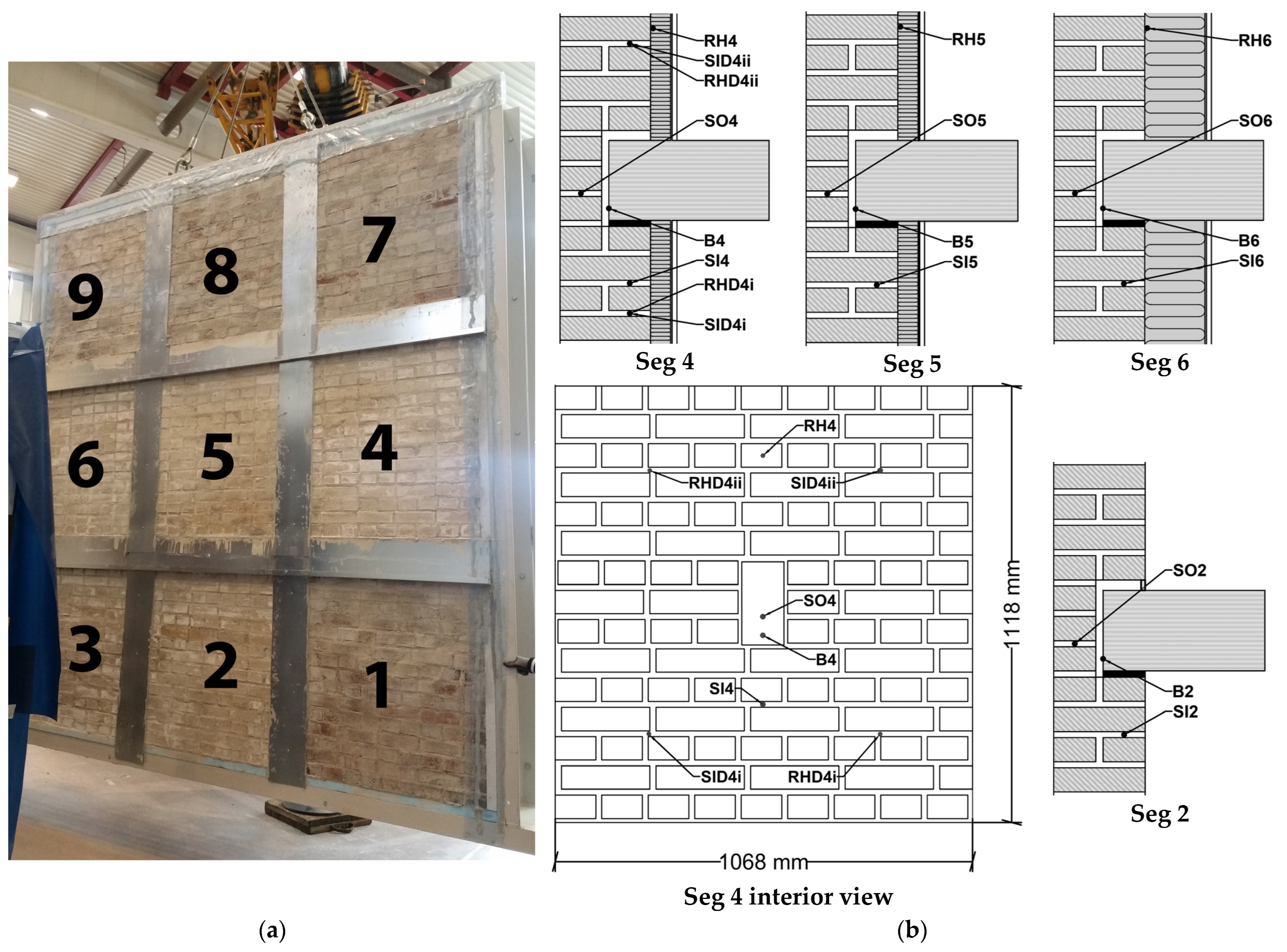
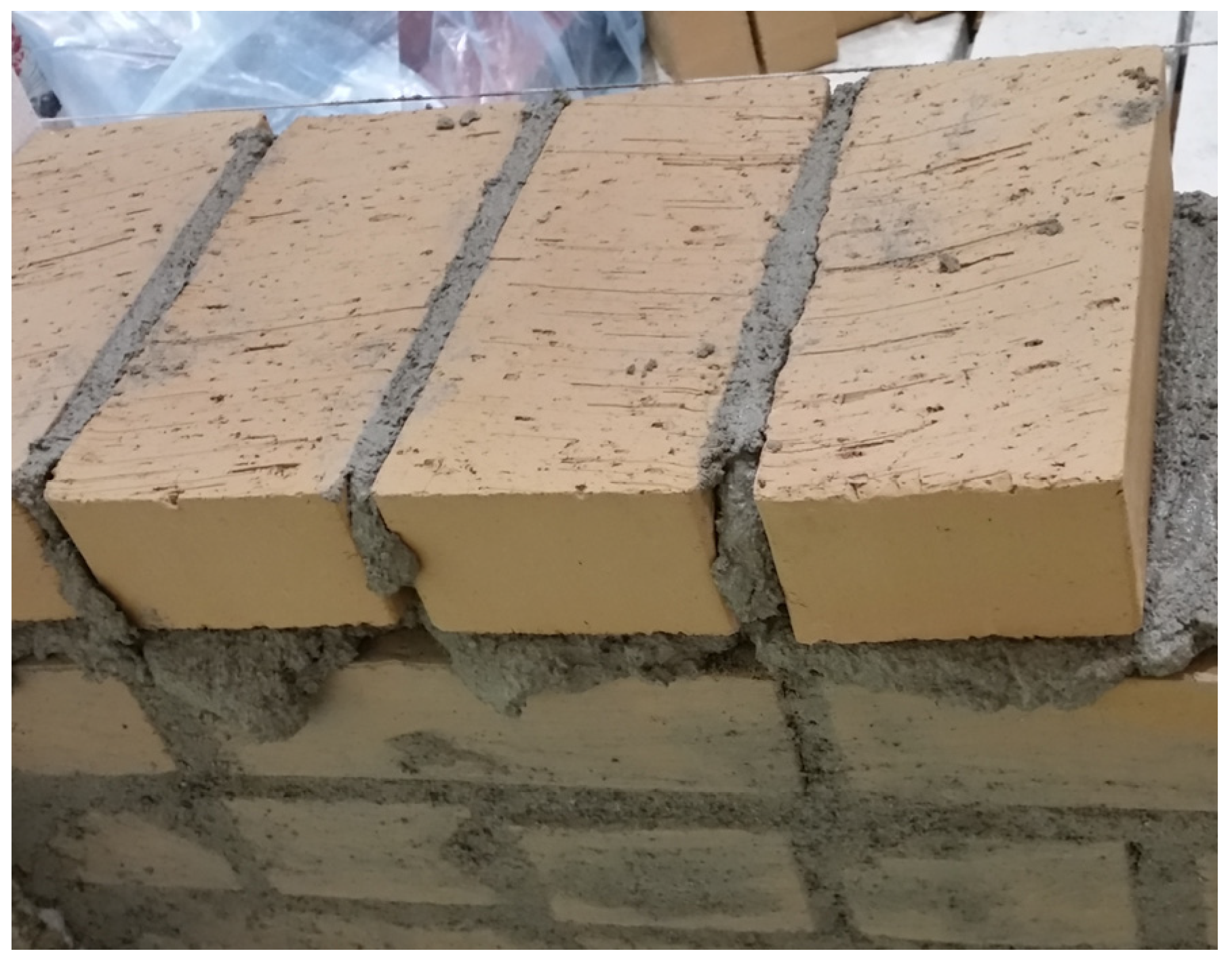

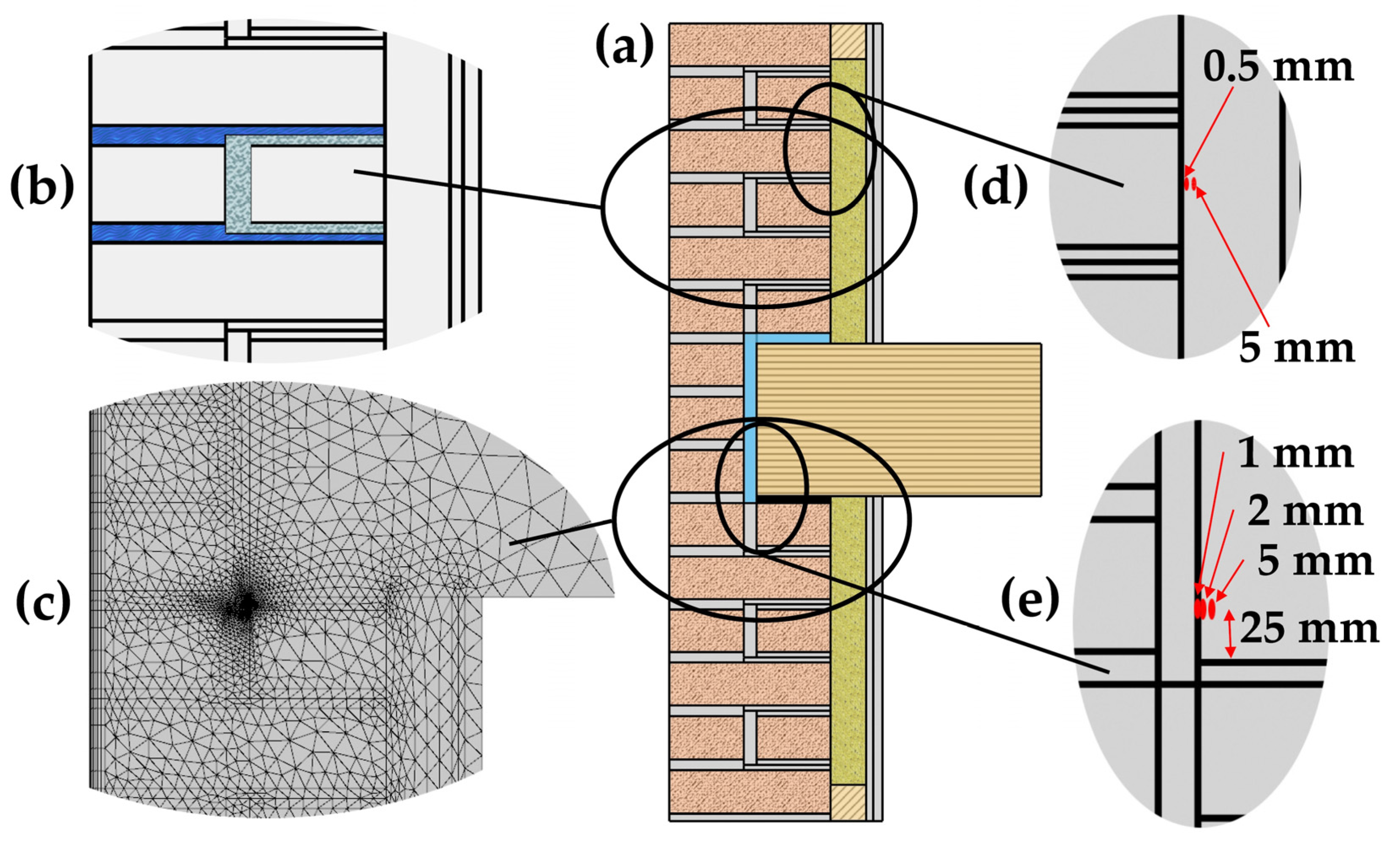
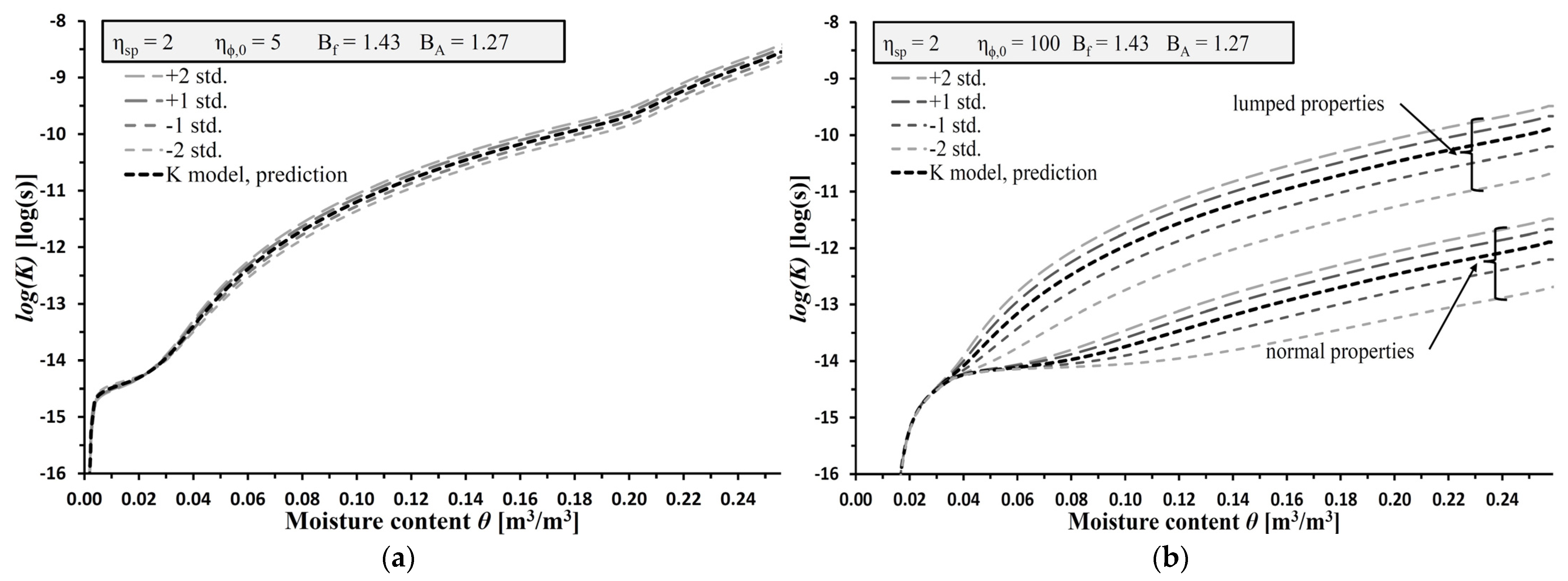

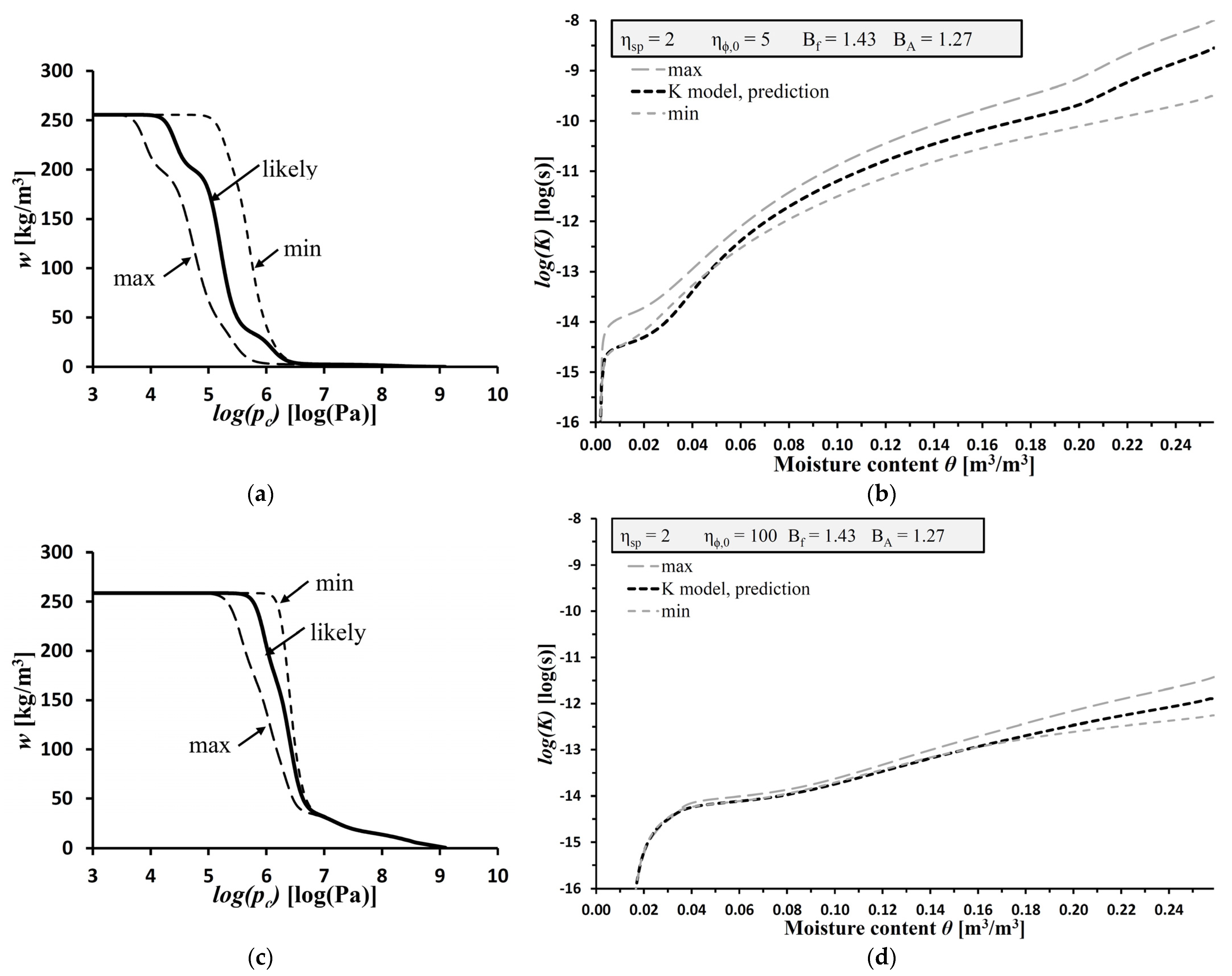
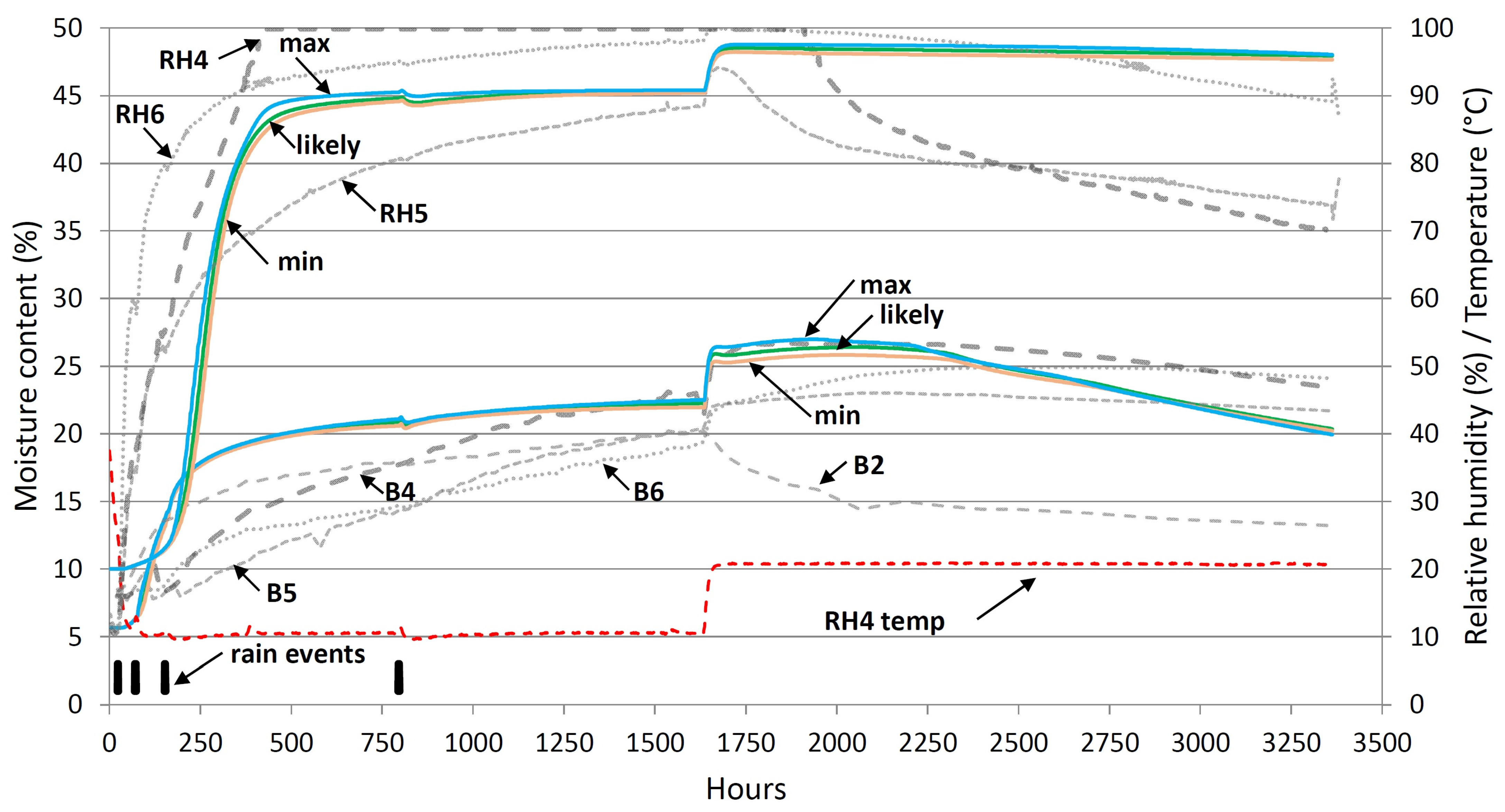
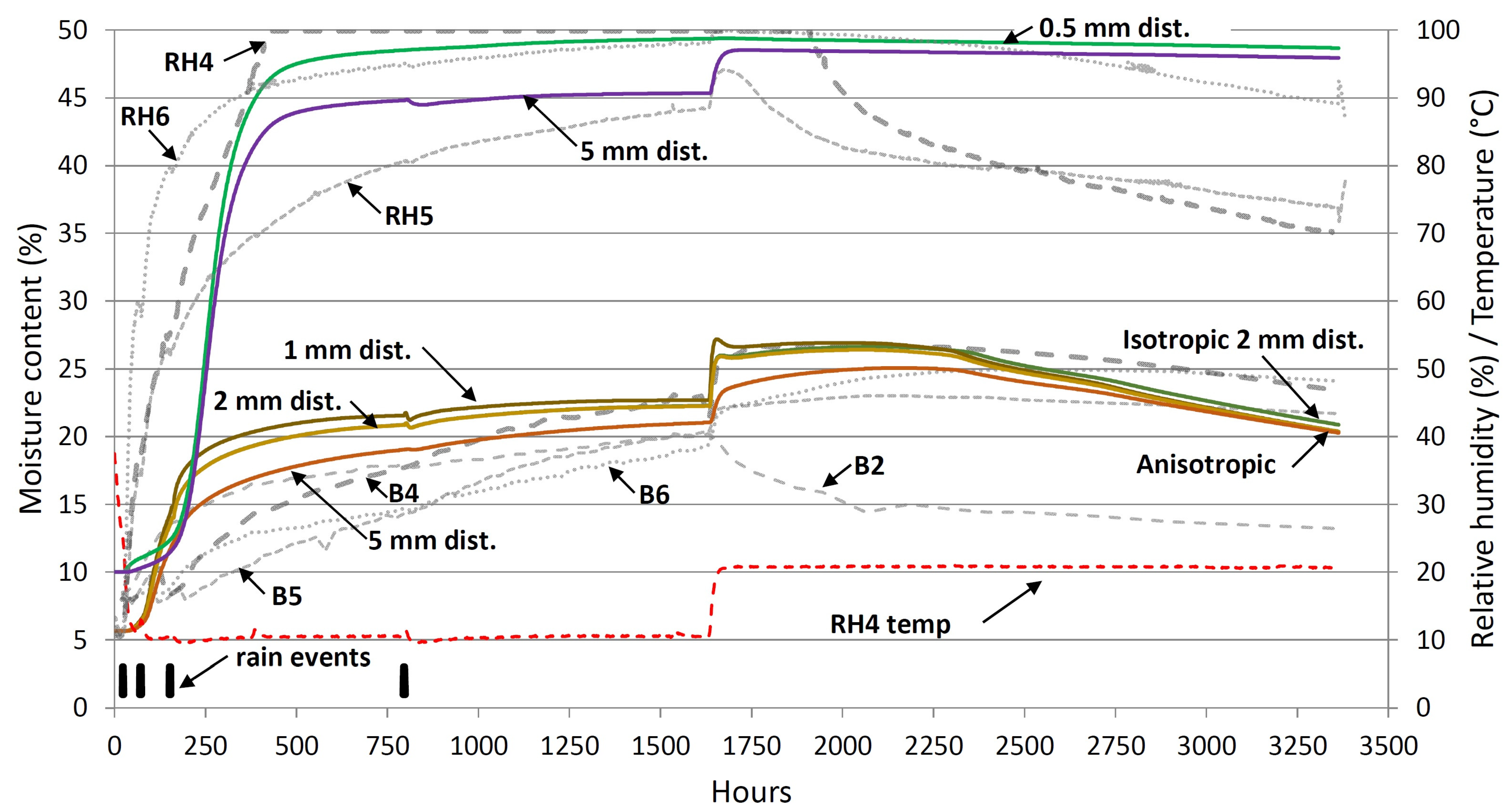
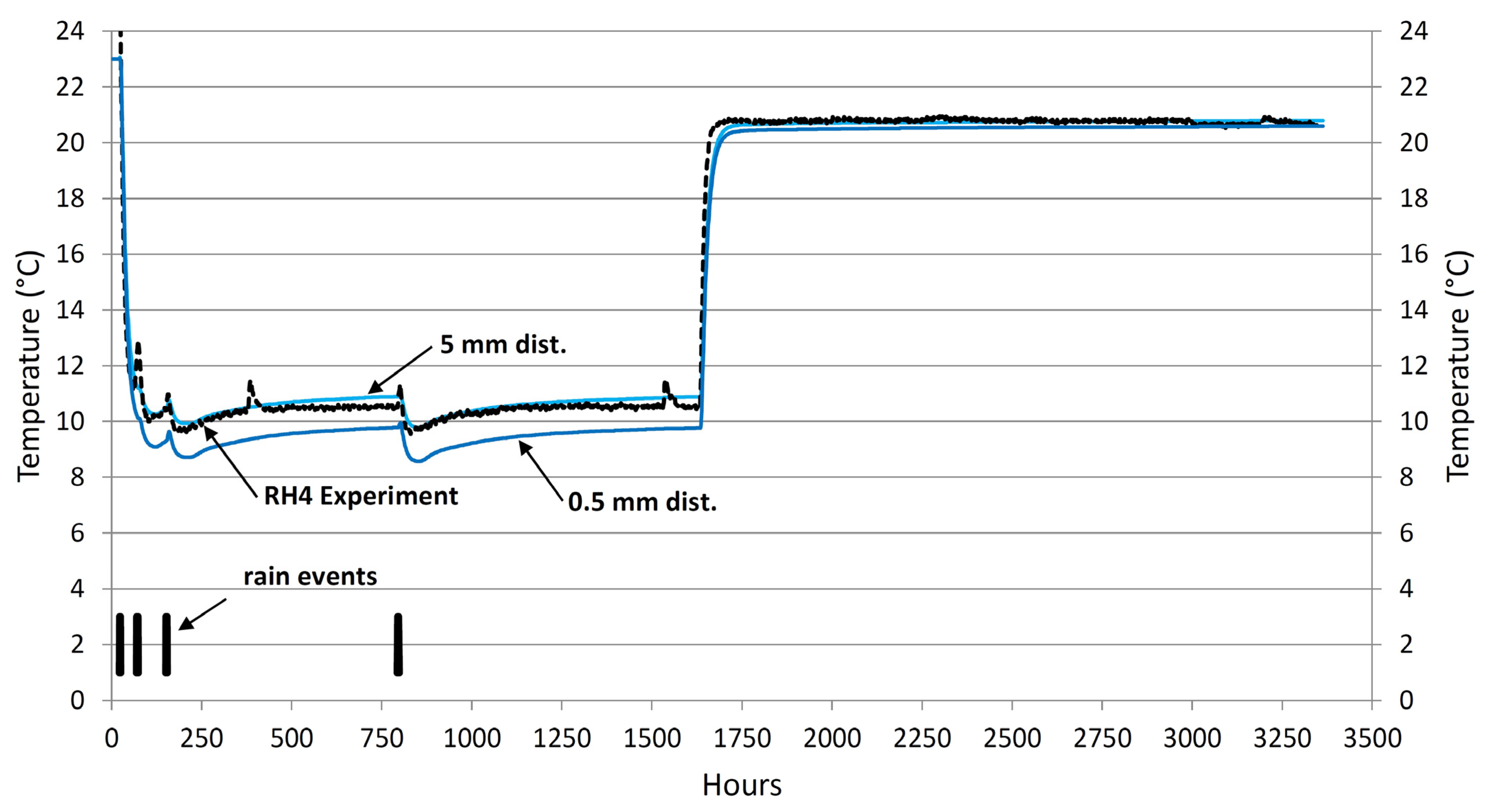
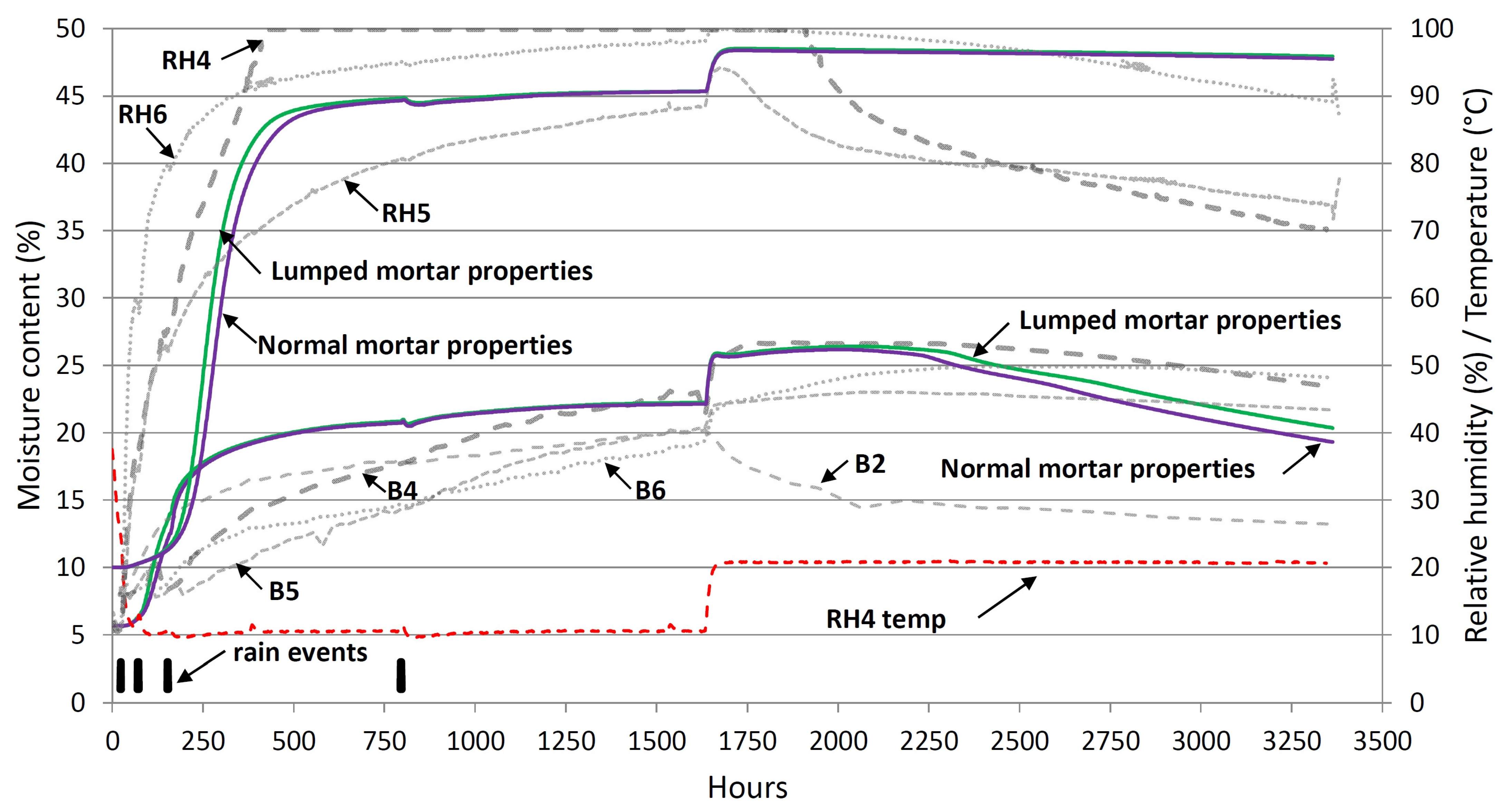
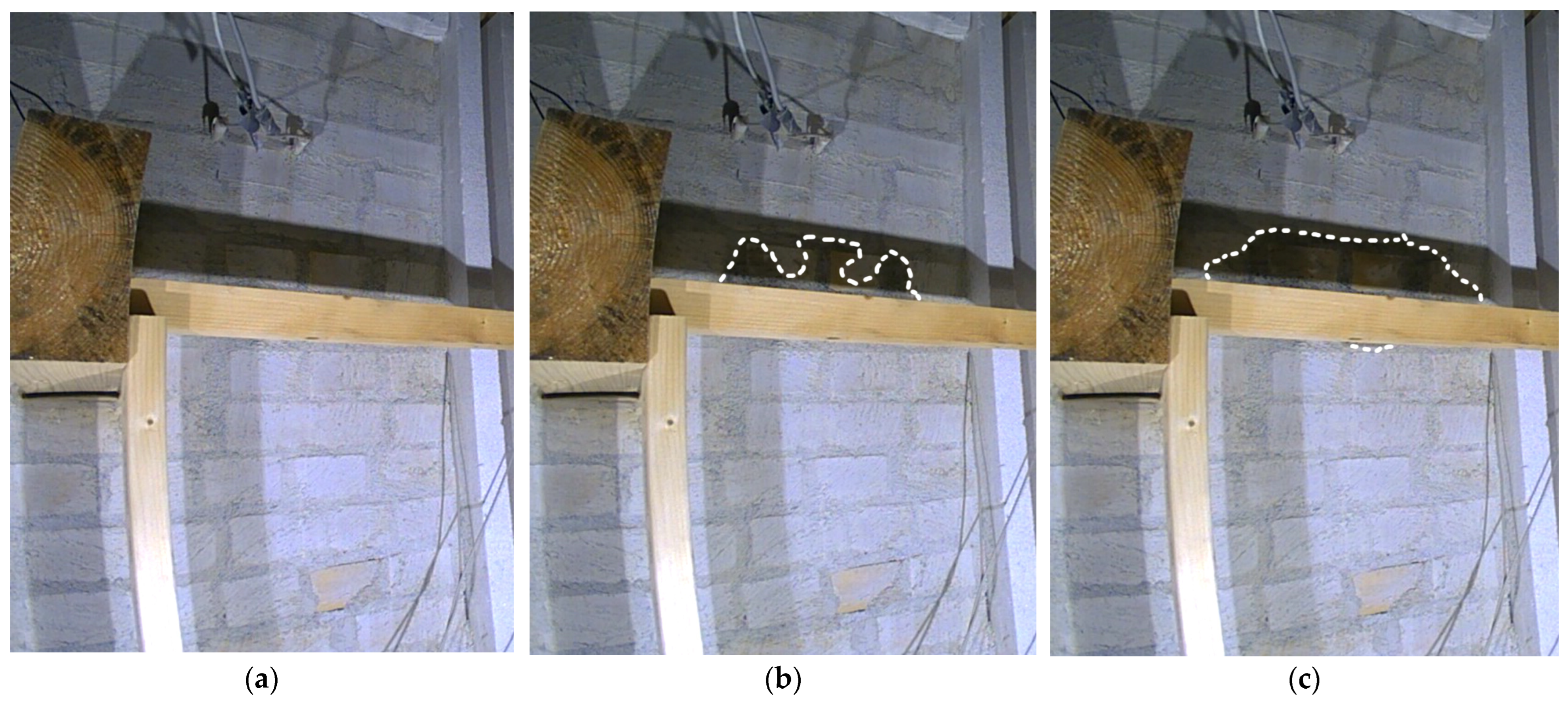
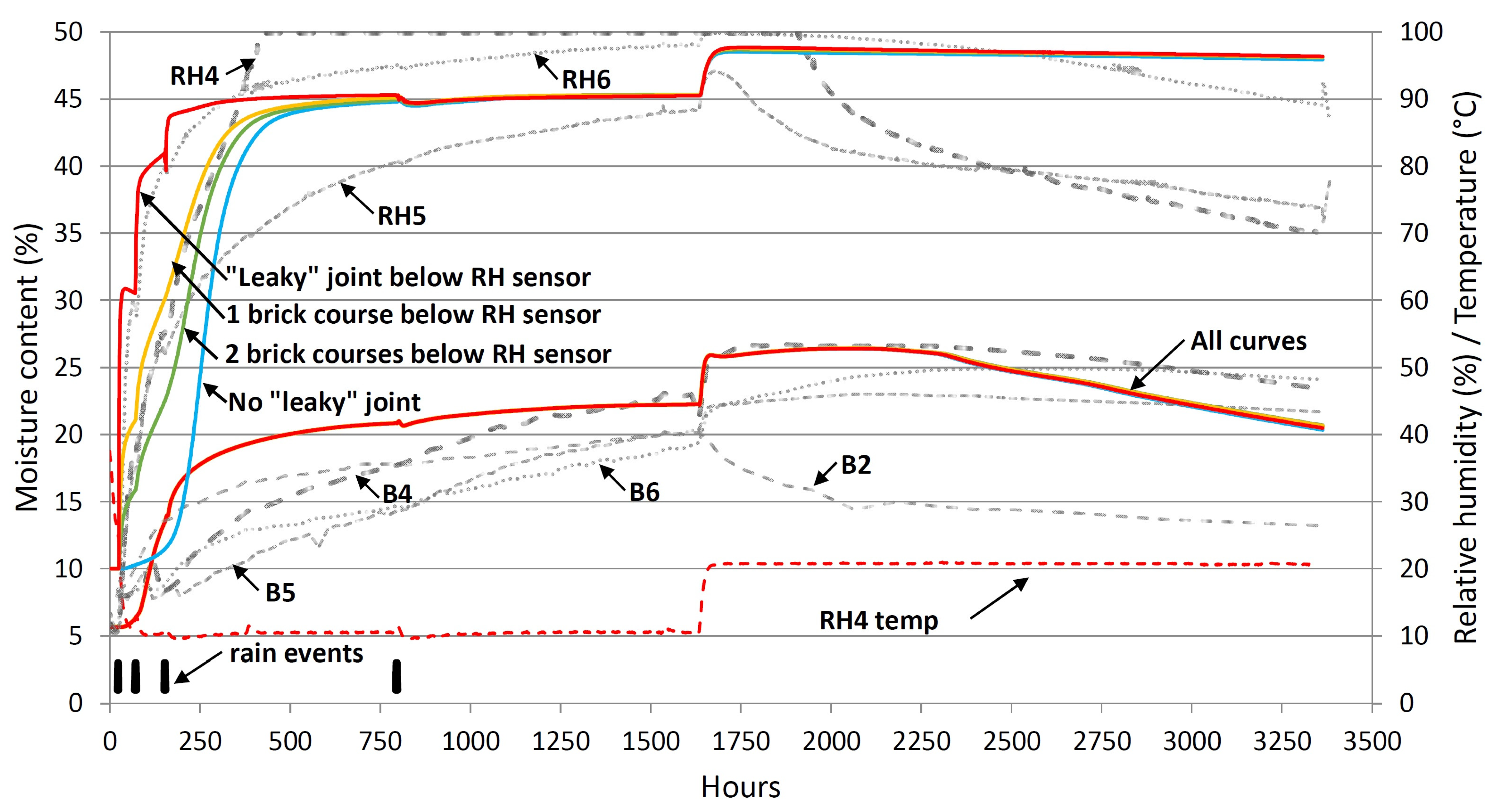
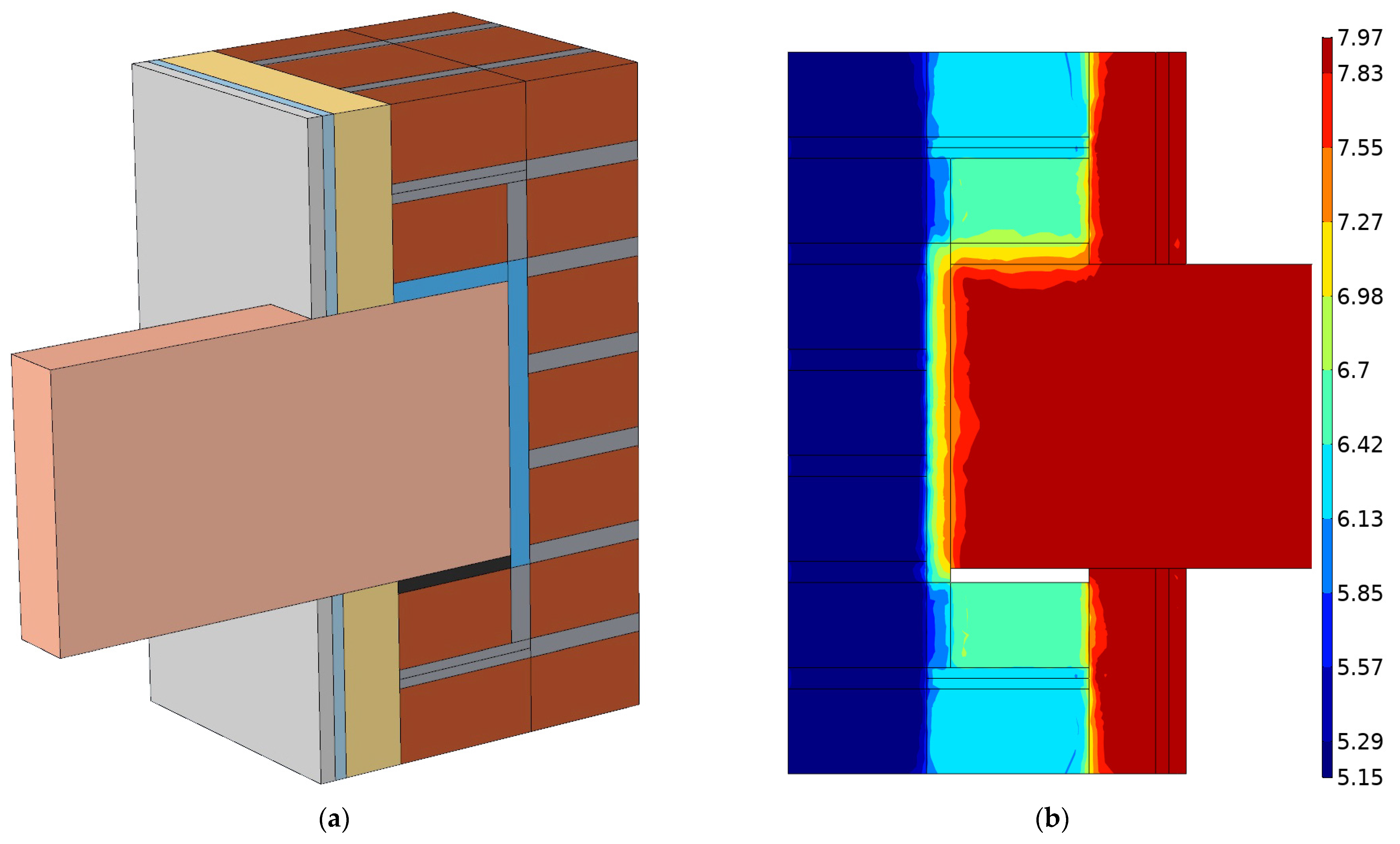
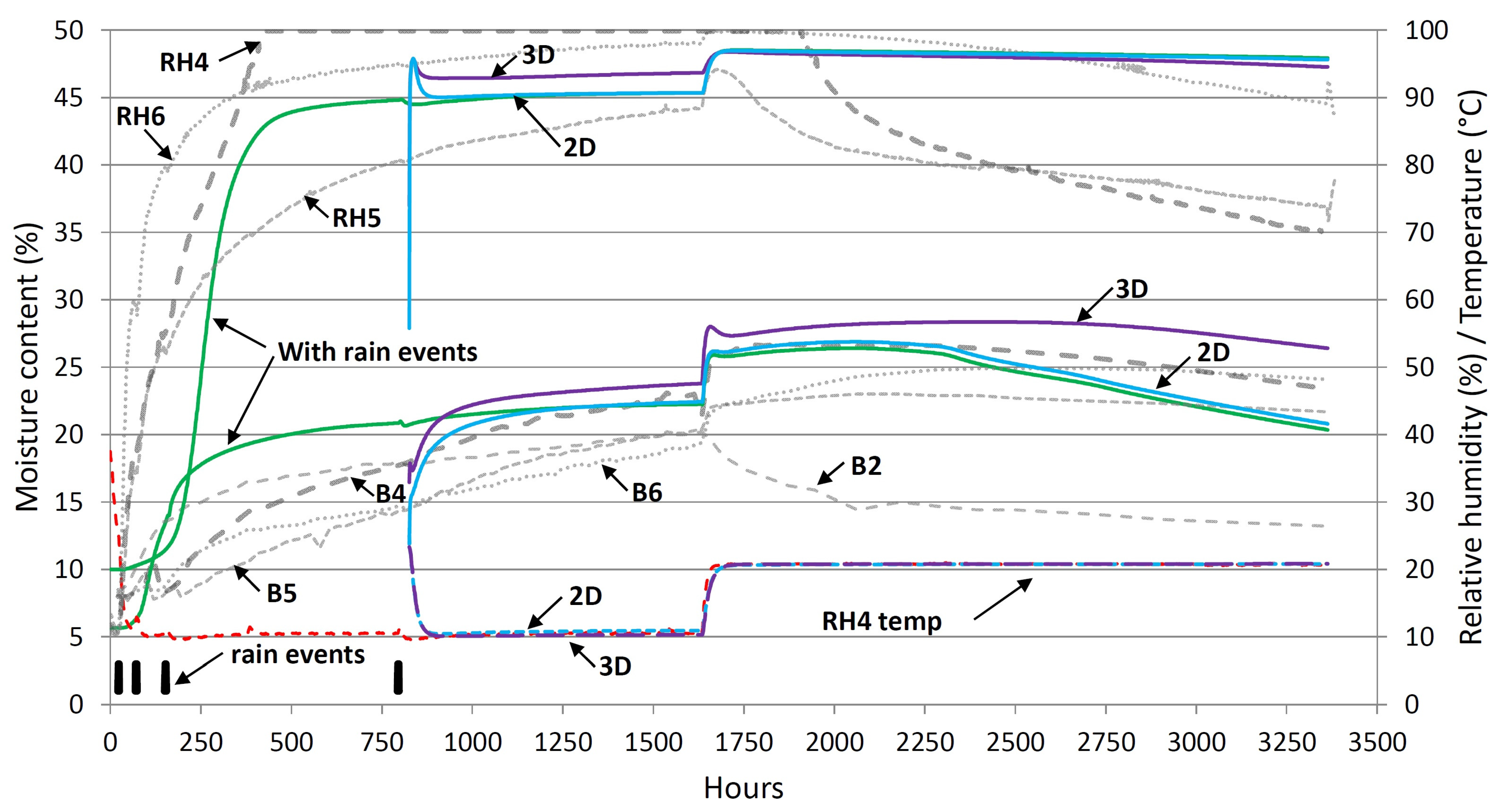
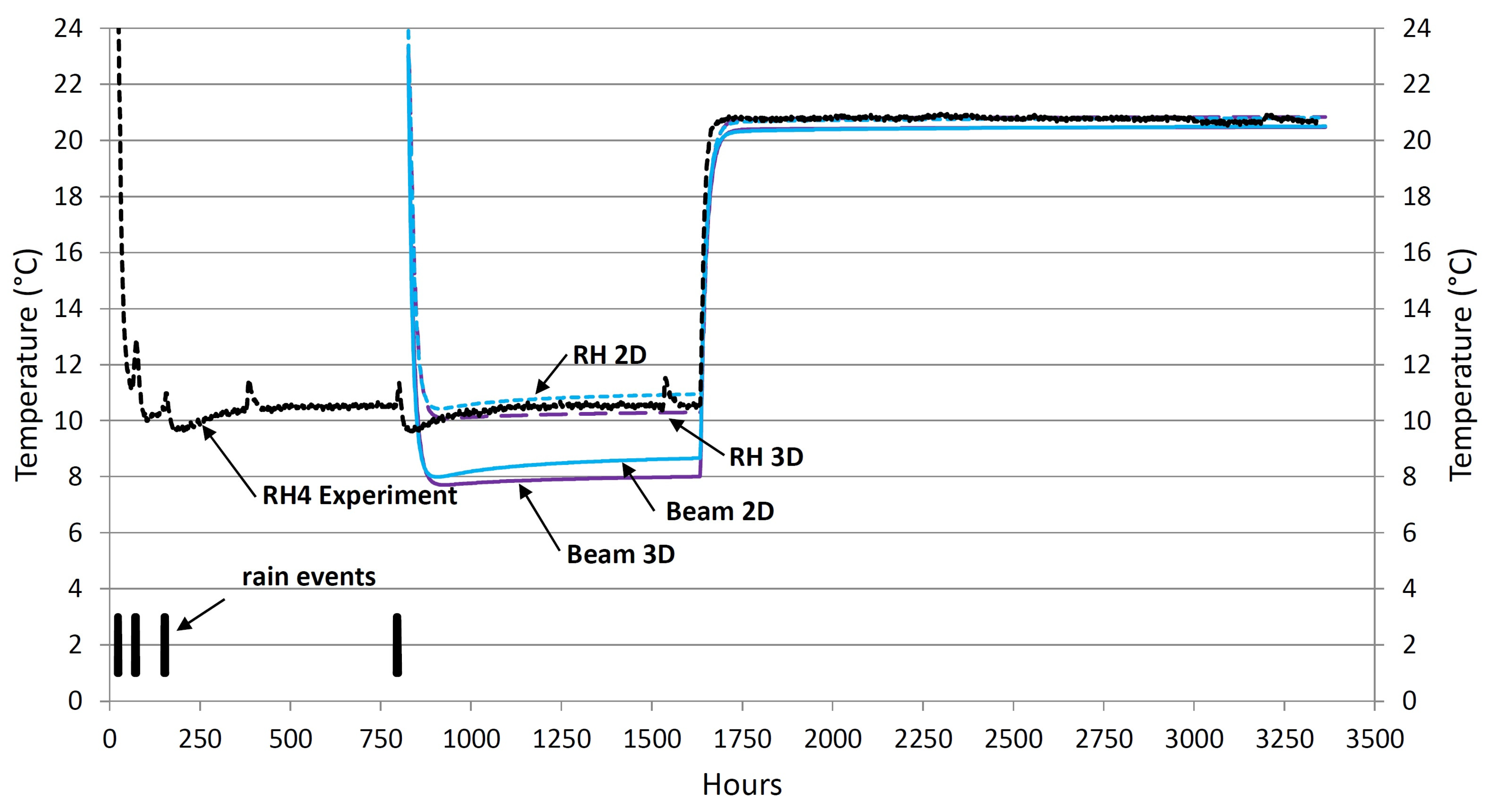
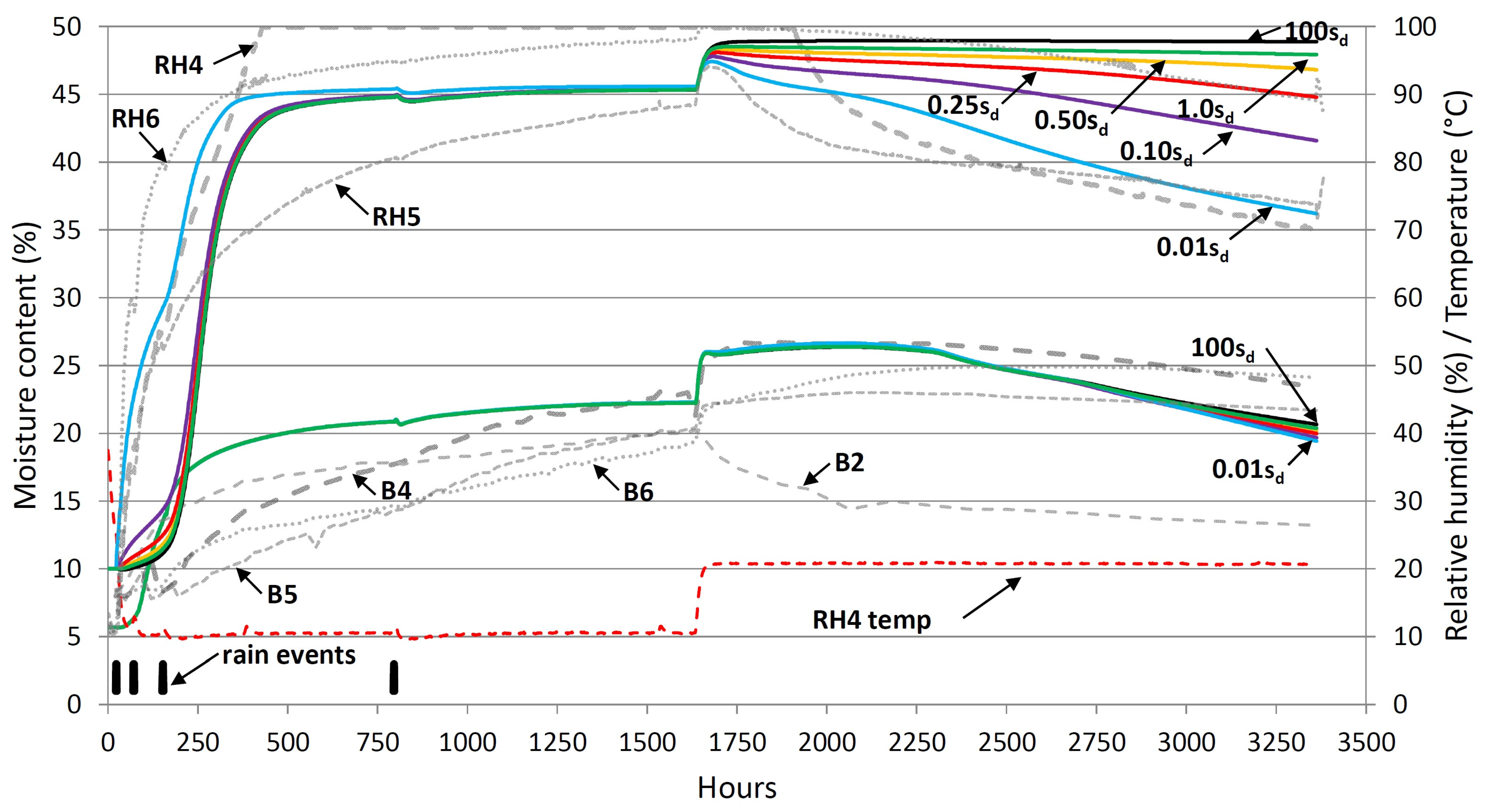
| Storage | Determination | Transport | Determination | |
|---|---|---|---|---|
| General | Density, ρs | Mea. | ||
| Heat | Specific heat capacity, cp | Sta. | Thermal conductivity, λ | Sta. (dry), Sim. (wet) |
| Moisture | Sorption (hygroscopic), w(ϕ) | Mea. | Vapor diffusivity, δv | Mea. |
| Retention (over-hygroscopic), w(pc) | Sim. | Hydraulic conductivity, K(pc) | Mod. | |
| Capillary moisture content, wcap | Mea. (brick)/Mea. Sim. (mortar) | Capillary absorption coefficient, Aw | Mea. (brick)/Mea. Sim. (mortar) | |
| Saturated moisture content, wsat | Est. Sim. |
Disclaimer/Publisher’s Note: The statements, opinions and data contained in all publications are solely those of the individual author(s) and contributor(s) and not of MDPI and/or the editor(s). MDPI and/or the editor(s) disclaim responsibility for any injury to people or property resulting from any ideas, methods, instructions or products referred to in the content. |
© 2023 by the authors. Licensee MDPI, Basel, Switzerland. This article is an open access article distributed under the terms and conditions of the Creative Commons Attribution (CC BY) license (https://creativecommons.org/licenses/by/4.0/).
Share and Cite
Knarud, J.I.; Kvande, T.; Geving, S. Hygrothermal Simulation of Interior Insulated Brick Wall—Perspectives on Uncertainty and Sensitivity. Buildings 2023, 13, 1701. https://doi.org/10.3390/buildings13071701
Knarud JI, Kvande T, Geving S. Hygrothermal Simulation of Interior Insulated Brick Wall—Perspectives on Uncertainty and Sensitivity. Buildings. 2023; 13(7):1701. https://doi.org/10.3390/buildings13071701
Chicago/Turabian StyleKnarud, Jon Ivar, Tore Kvande, and Stig Geving. 2023. "Hygrothermal Simulation of Interior Insulated Brick Wall—Perspectives on Uncertainty and Sensitivity" Buildings 13, no. 7: 1701. https://doi.org/10.3390/buildings13071701
APA StyleKnarud, J. I., Kvande, T., & Geving, S. (2023). Hygrothermal Simulation of Interior Insulated Brick Wall—Perspectives on Uncertainty and Sensitivity. Buildings, 13(7), 1701. https://doi.org/10.3390/buildings13071701





